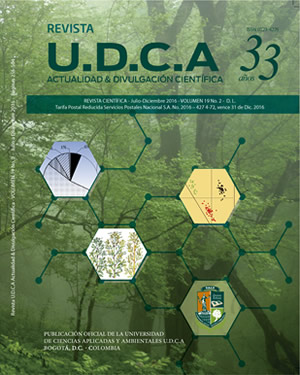Infecciones zoonóticas causadas por levaduras del género Malassezia: una revisión
Zoonotic infections caused by Malassezia yeasts: a review
Contenido principal del artículo
Resumen
Palabras clave:
Descargas
Datos de publicación
Perfil evaluadores/as N/D
Declaraciones de autoría
- Sociedad académica
- Universidad de Ciencias Aplicadas UDCA
- Editorial
- Universidad de Ciencias Aplicadas y Ambientales U.D.C.A
Detalles del artículo
Referencias (VER)
AL-SWEIH, N.; AHMAD, S.; JOSEPH, L.; KHAN, S.; KHAN, Z. 2014. Malassezia pachydermatis fungemia in a preterm neonate resistant to fluconazole and flucytosine. Med. Mycol. (Alemania). 5:9-11.
ARENDRUP, M.; BOEKHOUT, T.; AKOVA, M.; MEIS, J.; CORNELY, O. 2014. ESCMID and ECMM joint clinical guidelines for the diagnosis and management of rare invasive yeast infections. Clin. Microbiol Infect. (Israel). 20(3):76-98.
BANDHAYA, M. 1993. The distribution of Malassezia furfur and Malassezia pachydermatis on normal human skin. Southeast Asian J. Trop. Med. Public Health. (Tailandia). 24(2):343-346.
BERNIER, V.; WEILL, F.; HIRIGOYEN, V.; ELLEAU, C.; FEYLER, A. 2002. Skin colonization by Malassezia species in neonates: a prospective study and relationship with neonatal cephalic pustulosis. Arch Dermatol. (Alemania).138(2):215-218.
BOKONY, B.; BALINT, E.; SZABO, N.; HEGEDUS, G.T. 2014. Isolation of Malassezia furfur from canine skin scrapings. Magyar Allatorvosok Lapja. (Hungría). 136(1):41-44.
BOND, R. 2010. Superficial veterinary mycoses. ClinDermatol. (EUA). 28:226-236.
BOND, R.; GUILLOT, J.; CABAÑES, F. 2010. Malassezia yeasts in animal disease. En: Boekhout, T.; Guého, E.; Mayser, P.; Velegraki, A. (eds). Malassezia and the skin. Ed. Springer-Verlag (Alemania). p.291-292.
CABAÑES, F.; HERNÁNDEZ, J.; CASTELLÁ, G. 2005. Molecular analysis of Malassezia sympodialis-related strains from domestic animals. J. Clin. Microbiol. (EUA). 43(1):277-283.
CABAÑES, F. 2008. Micosis y zoonosis: Cryptococcusspp. Rev. Iberoam. Micol. (España). 25:S1-S3.
CAFARCHIA, C.; GASSER, R.; LATROFA, M.; PARISI, A.; CAMPBELL, B. 2008. Genetic variants of Malassezia pachydermatis from canine skin: body distribution and phospholipase activity. FEMS Yeast Res. (Suecia). 8:451-459.
CAFARCHIA, C.; GASSER, R.; FIGUEREDO, L.; LATROFA, M.; OTRANTO, D. 2011a. Advances in the identification of Malassezia. Mol. Cell. Probes. (Alemania).25(1):1-7.
CAFARCHIA, C.; LATROFA, M.; FIGUEREDO, L.; DA SILVA, M.; FERREIRO L. 2011b. Physiological and molecular characterization of atypical lipid-dependent Malassezia yeasts from a dog with skin lesions: adaptation to a new host? Med Mycol. (EUA). 49:365-374.
CANNON, R.; LAMPING, E.; HOLMES, A.; NIIMI, K.; BARET, P. 2009. Efflux-mediated antifungal drug resistance. Clin Microbiol Rev. (EUA). 22(2):291-321.
CASTELLÁ, G.; ABARCA, M.; CABAÑES, F. 2008. Criptococosis y animales de compañía. Rev. Iberoam. Micol. (España). 25:S19-S24.
CHANG, H.; MILLER, H.; WATKINS, N.; ARDUINO, M.; ASHFORD, D. 1998. An epidemic of Malassezia pachydermatis in an intensive care nursery associated with colonization of health care workers' pet dogs. N. Eng. J. Med. 338(11):706-711.
CHEN, I.; CHIU, N.; CHI, H.; HSU, C.; CHANG, J. 2015. Changing of bloodstream infections in a medical center neonatal intensive care unit. J. Microbiol. Immunol. Infect. (Taiwan). Epub ahead of print. doi: 10.1016/j.jmii.2015.08.023.
CHITTY, J.; HENDRICKS, A. 2007. Zoonotic skin disease in small animals. In Practice. (Inglaterra). 29:92-97.
CHOUDHURY, S.; MARTE, R. 2014. Malassezia pachydermatis fungaemia in an adult on posaconazole prophylaxis for acute myeloid leukaemia. Pathology (Australia). 46(5):450-472.
CHRYSSANTHOU, E.; BROBERGER, U.; PETRINI, B. 2001. Malassezia pachydermatis fungaemia in a neonatal intensive care unit. Acta Paediatr. (Suecia). 90:323-327.
DE BONA, E.; TELESCA, S.; FUENTEFRIA, A. 2012. Occurrence and identification of yeast in dog's external ear with and without otitis. Rev MVZ Cordoba. (Colombia). 17(2):3059-3064.
DUARTE, E.; HAMDAN, J. 2008. Molecular characterization of Malassezia sympodialis and Malassezia furfur from cattle whit and without otitis. Arq. Bras. Med. Vet. Zootec. 60(4):779-785.
DUFAIT, R. 1983. Pityrosporum canis as the cause of canine chronic dermatitis. Veterinary Medicine and Small Animal Clinician. (EUA). 78:1055-1057.
FAN, Y.; HUANG, W.; LI, S.; WU, G.; LAI, K. 2006. Granulomatous skin infection caused by Malassezia pachydermatis in a dog owner. AMA Arch. Derm. (EUA). 142:1181-1184.
FERREIRA, R.; GAMBALE, W.; GARCIA, R.; DA SILVA, L.; DURIGON, E. 2008. Malassezia spp. in acoustic meatus of bats (Molossus molossus) of the Amazon region, Brazil. Mycopathologia. (EUA). 165:21-26.
FINE, R.; SALUSKY, I.; HALL, T.; LUCULLO, L.; JORDAN, S. 1983. Peritonitis in children undergoing continuous ambulatory peritoneal dialysis. Pediatrics. (EUA). 71(5):806-809.
GAITANIS, G.; MAGIATIS, P.; HANTSCHKE, M.; BASSUKAS, I.; VELEGRAKI, A. 2012. The Malassezia genus in skin and systemic diseases. Clin Microbiol Rev. (EUA). 25(1):106-141.
GIRAO, M.; PRADO, M.; BRIHANTE, R.; CORDEIRO, R.; MONTEIRO, A. 2006. Malassezia pachydermatis isolated from normal and disease external ear canal in dogs: a comparative analysis. Vet J. (Brasil). 172(3):544-548.
GIUSIANO, G.; SOSA, M.; ROJAS, F.; VANACORE, S.; MANGIATERRA, M. 2010. Prevalence of Malassezia species in pityriasis versicolor lesions in northeast Argentina. Rev Iberoam Micol. (España). 27(2):71-74.
GORDON, M. 1979. Malassezia pityrosporum pachydermatis (Weidman) Dodge 1935. Sabouraudia. (EUA). 17(3):305-309.
GREENE, C. 2008. Enfermedades infecciosas del perro y el gato. 3ra Ed. Editorial Inter-Médica. Buenos Aires (Argentina). p.623-627.
GUÉHO, E.; SIMMONS, R.; PRUITT, W.; MEYER, S.; AHEARN, D. 1987: Association of Malassezia pachydermatis with systemic infections of humans. J. Clin. Microbiol. (EUA). 25(9):1789-1790.
GUILLOT, J.; GUÉHO, E.; CHÉVRIER, G.; CHERMETTE, R. 1997. Epidemiological analysis of Malassezia pachydermatis isolates by partial sequencing of the large subunit ribosomal RNA. Res Vet Sci. (Italia). 62:22-25.
GUILLOT, J.; BOND, R. 1999. Malassezia pachydermatis: a review. Med Mycol. (EUA). 37(5):295-306.
HAN, S.; CHUNG, T.; NAM, E.; PARK, S.; HWANG, C. 2013. Molecular analysis of Malassezia pachydermatis isolated from canine skin and ear in Korea. Med. Mycol. (EUA). 51(4):396-404.
HUBÁLEK, Z. 2003. Emerging human infectious diseases: anthroponoses, zoonoses and sapronoses. Emerg. Infect. Dis. (EUA). 9(3):403-404.
KAUR, M.; NARANG, T.; BALA, M.; GUPTE, S.; AGGARWAL, P. 2013. Study of the distribution of Malassezia species in patients with pityriasis versicolor and healthy individuals in Tertiary Care Hospital, Punjab. Indian J. Med. Microbiol. 31:270-274.
LAROCCO, M.; DORENBAUM, A.; ROBINSON, A.; PICKERING, L. 1988. Recovery of Malassezia pachydermatis from eight infants in a neonatal intensive care nursery: clinical and laboratory features. Pediatr. Infect. Dis J. (EUA). 7(6):398-401.
LAUTENBACH, E.; NACHAMKIN, I.; SCHUSTER, M. 1998. Malassezia pachydermatis infections. N. Eng. J. Med. 339(4):266-273.
LEDBETTER, E.; STARR, J. 2015. Malassezia pachydermatis keratomycosis in a dog. Med. Mycol. (EUA). 10:24-26.
LEFEBVRE, S.; WALTNER, D.; PEREGRINE, A.; REID, R.; HODGE, L. 2006. Prevalence of zoonotic agents in dogs visiting hospitalized people in Ontario: implications for infection control. J. Hosp Infect. (Inglaterra). 62:458-466.
MANI, I.; MAGUIRE, J. 2009. Small animal zoonoses and immunocompromised pet owners. Top Companion Anim. Med. (EUA). 24(4):164-174.
MARCON, M.; POWELL, D. 1992. Human infections due to Malassezia spp. Clin. Microbiol. Rev. (EUA). 5(2):101-119.
MARCUS, L.; MARCUS, E. 1998. Nosocomial zoonoses. N. Engl. J. Med. 338(11):756-759.
MESTRONI, S.; VERNA, J.; SMOLKIN, A.; BAVA, A. 2003. Etiological factors of fungemia in the Hospital San Martín in La Plata. Rev. Argent. Microbiol. 35(2):106-109.
MICKELSEN, P.; VIANO, M.; STEVENS, D.; DIAZ, P. 1988. Clinical and microbiological features of infection with Malassezia pachydermatis in high-risk infants. J. Infect. Dis. (EUA).157(6):1163-1168.
MORRIS, D.; O'SHEA, K.; SHOFER, F.; RANKIN, S. 2005. Malassezia pachydermatis carriage in dog owners. Emerg. Infect. Dis. (EUA). 11(1):83-88.
NARDONI, S.; DINI, M.; TACCINI, F.; MANCIANTI, F. 2007. Occurrence, distribution and population size of Malassezia pachydermatis on skin and mucosae of atopic dog. Vet. Microbiol. (Australia). 122(1-2):172-177.
NARDONI, S.; MERILDI, V.; FRANGIONI, S.; ARITI, G.; VERIN, R.; VANNUCCI, P.; MANCIANTI, F. 2010. Isolation and characterization of Malassezia spp. In healthy swine of different breeds. Veterinary Microbiology. (Italia). 14: 155-158.
NENOFF, P.; HANDRICK, W.; KRÜGER, C.; VISSIENNON, T.; WICHMANN, K. 2012. Dermatomycoses due to pets and farm animals: neglected infections? Hautarzt. (Alemania). 63(11):848-858.
PACHECO, A. 2003. Mascotas en los hogares: enfermedades de los niños adquiridas por convivencia con animales. Enf. Infec. y Micro. (España). 23(4):137-148.
PERALAM, P.; SRIPATHI, H.; BAIRY, I.; LONIKAR, V.; RAO, R. 2009. Zoonotic sporotrichosis of lymphocutaneous type in a man acquired from a domesticated feline source: report of a first case in southern Karnataka, India. Int. J. Dermatol. (EUA). 48:1198-1200.
PRADO, M.; BRITO, E.; GIRÃO, M.; MONTEIRO, A.; SIDRIM, J. 2004. Higher incidence of Malassezia pachydermatis in the eyes of dogs with corneal ulcer than in healthy dogs. Vet Microbiol. (Australia).100(20):115-120.
PROHIC, A.; KASUMAGIC, E. 2009. Identification of Malassezia pachydermatis from healthy and diseased human skin. Med. Arch. (Bosnia y Herzegovina). 63(6):317-319.
PROHIC, A.; JOVOVIC, T.; KRUPALIJA, M.; KUSKUNOVIC, S. 2016. Malassezia species in healthy skin and in dermatological conditions. Int. J. Dermatol. (USA). 55:494-504.
PULIDO, A.; CASTAÑEDA, R.; LINARES, M.; MERCADO, M. 2008. Clinical-microbiological diagnostic of external otitis in canines in Bogotá, Colombia. Rev. MVZ Córdoba. (Colombia). 15(3):2215-2222.
PULIDO, A.; CASTAÑEDA, R.; LINARES, M.; MERCADO, M. 2015. Concordance between otic cytology and culture in diagnosis of external otitis canine by Malassezia spp. Rev. MVZ Córdoba. (Colombia).20(3):4720-4724.
RINCÓN, S.; CELIS, A.; SOPÓ, L.; MOTTA, A.; CEPERO, M. 2005. Malassezia yeast species isolated from patients with dermatologic lesions. Biomédica. (Colombia). 25:189-195.
ROMANO, A.; SEGAL, E.; BLUMENTHAL, M. 1978. Canaliculitis with isolation of Pityrosporum pachydermatis Br. J. Ophthalmol. 62:732-734.
SCOTT, D.; MILLER, W.; GRIFFIN, C. 2002. Dermatología en pequeños animales. 6ta edición. Editorial Inter-Médica. (Argentina). 380-393.
SHOKRI, H.; KHOSRAVI, A. 2016. An epidemiological study of animal dermatomycosis in Iran. J. Mycol Med. (Iran). (2):170-177.
SEYEDMOUSAVI, S.; GUILLOT, J.; TOLOOE, A.; VERWEIJ, P.; DE HOOG, G. 2015. Neglected fungal zoonoses: hidden threats to man and animals. Clin Microbiol Infect. (Israel). 21(5):416-425.
SOMERVILLE, D. 1971. Colonisation by Pityrosporum pachydermatis. Lancet. (Inglaterra). 17(1):799.
SOSA, M.; ROJAS, F.; MANGIATERRA, M.; GIUSIANO, G. 2013. Prevalencia de especies de Malassezia asociadas a lesiones de dermatitis seborreica en pacientes de Argentina. Rev. Iberoam. Micol. (España).30(4):239-242.
VAN BELKUM, A.; BOEKHOUT, T.; BOSBOOM, R. 1994. Monitoring spread of Malassezia infections in a neonatal intensive care unit by PCR-mediated genetic typing. J. Clin. Microbiol. (EUA). 32(10):2528-2532.
WELBEL, S.; MCNEIL, M.; PRAMANIK, A.; SILBERMAN, R.; OBERLE, A. 1994. Nosocomial Malassezia pachydermatis blood-stream infections in a neonatal intensive care unit. Pediatr. Infect. Dis. J. (EUA).13(2):104-108.
WORLD HEALTH ORGANIZATION. 1967. Joint WHO/ FAO expert committee on zoonoses, 3rd report. WHO Technical Report Series. (Italia). 378.
YURAYART, C.; CHINDAMPORN, A.; SURADHAT, S.; TUMMARUK, P.; KAJIWARA, S. 2011. Comparative analysis of the frequency, distribution and population sizes of yeasts associated with canine seborrheic dermatitis and healthy skin. Vet. Microbiol. (Australia). 148(2-4):356-362.
ZIA, M.; MIRHENDI, H.; TOGHYANI, M. 2015. Detection and identification of Malassezia species in domestic animal and acuatic birds by PCR-RFLP. Iran J. Vet. Res. 16(1):36-41.







